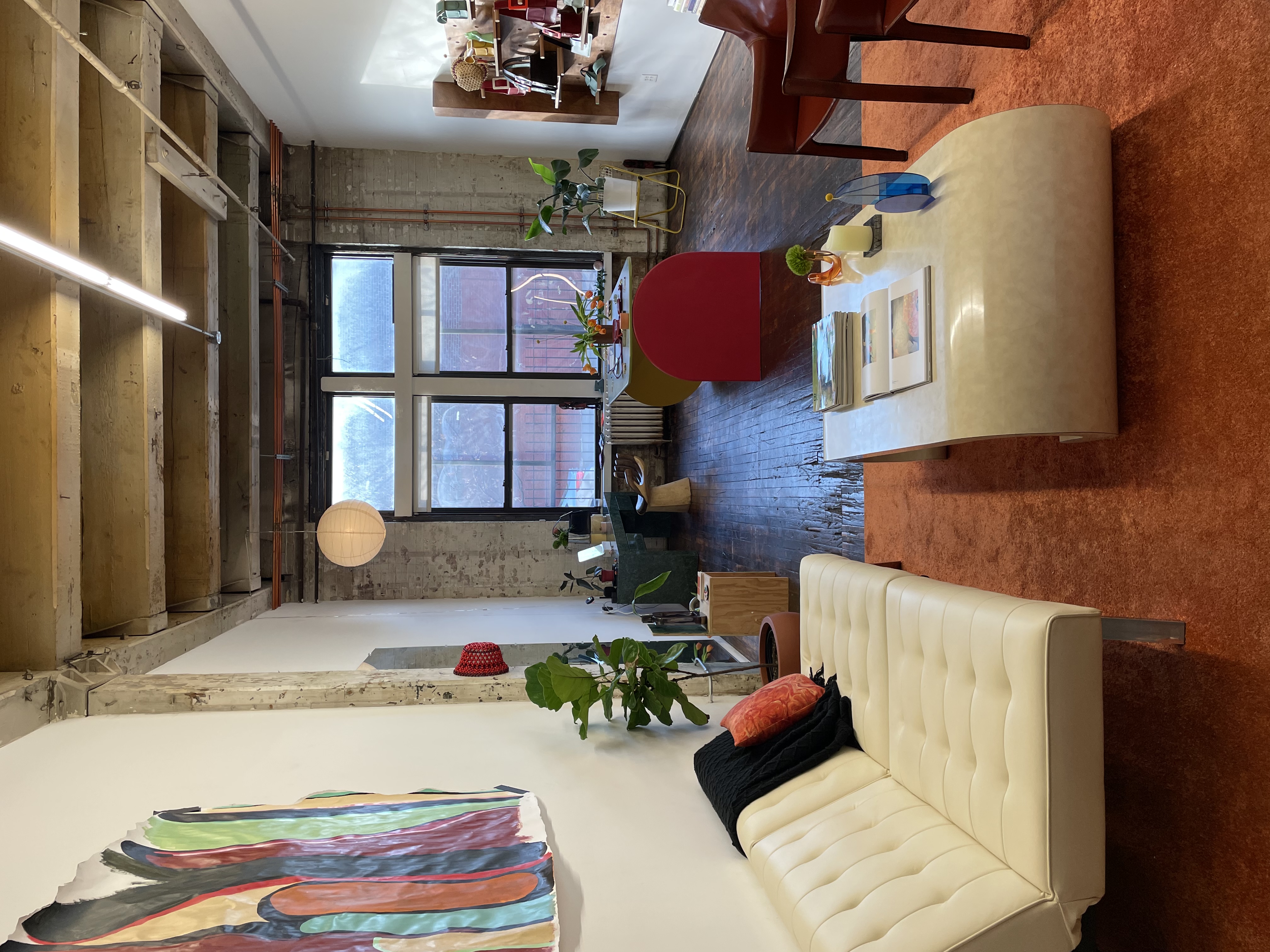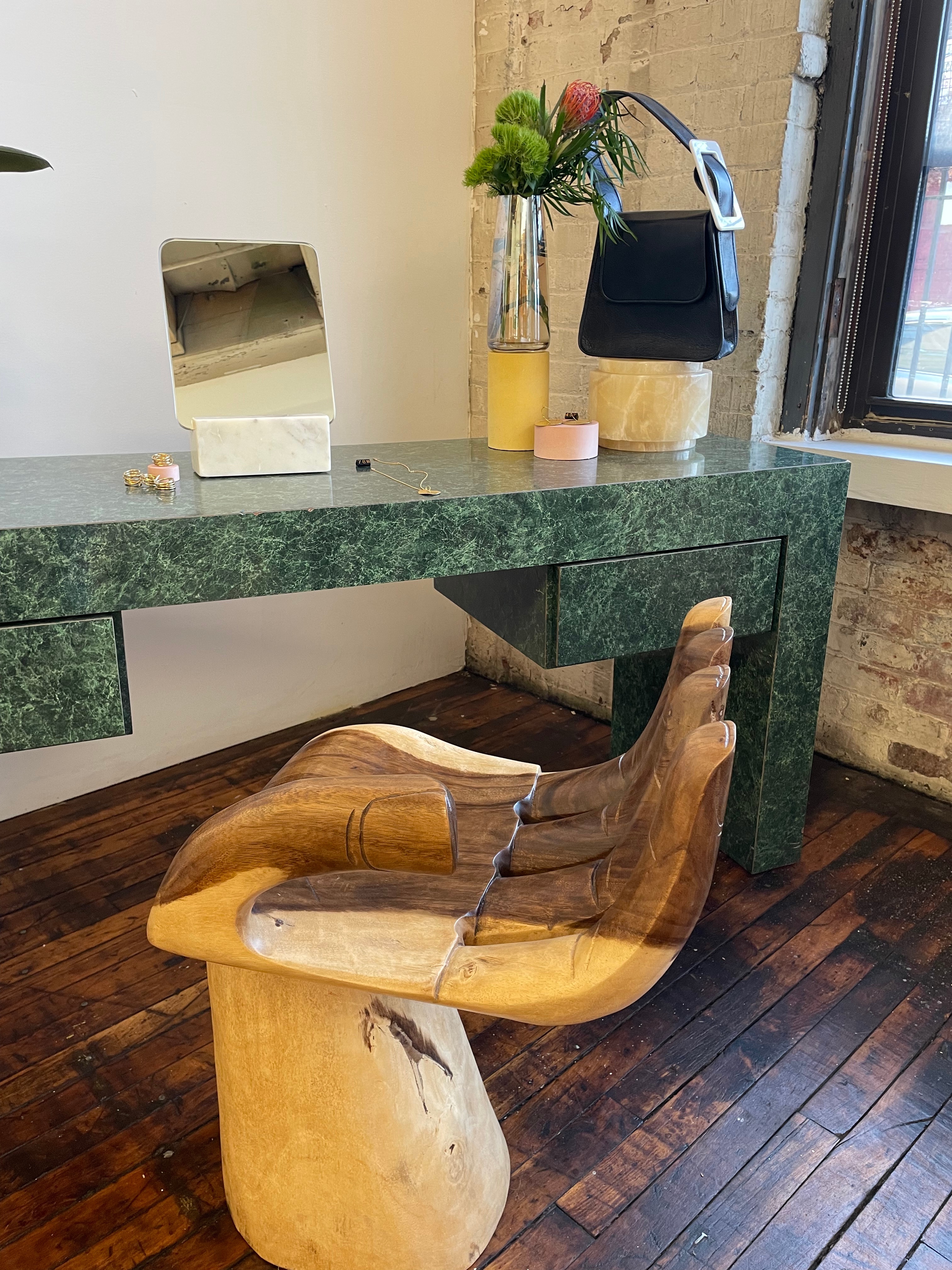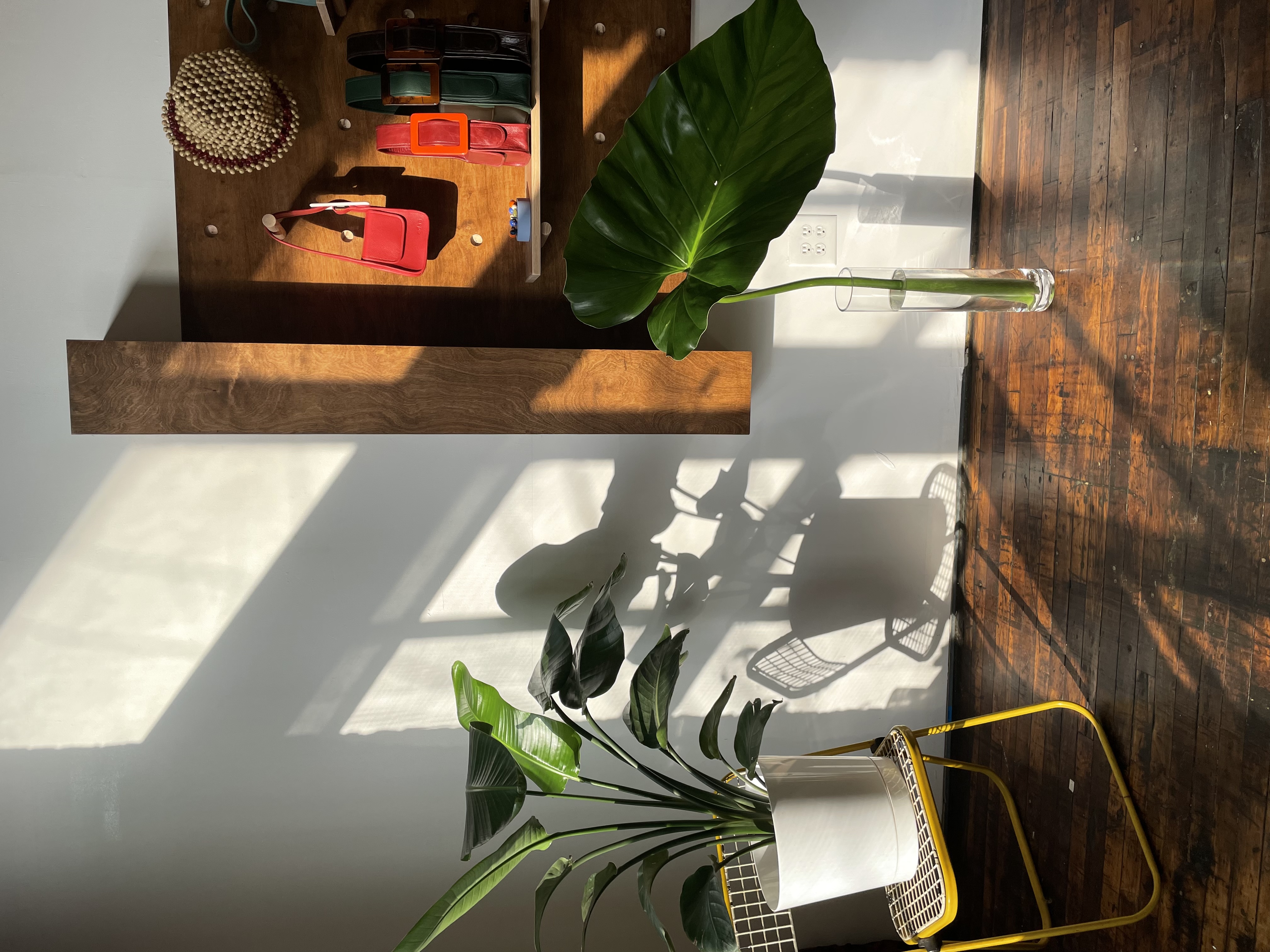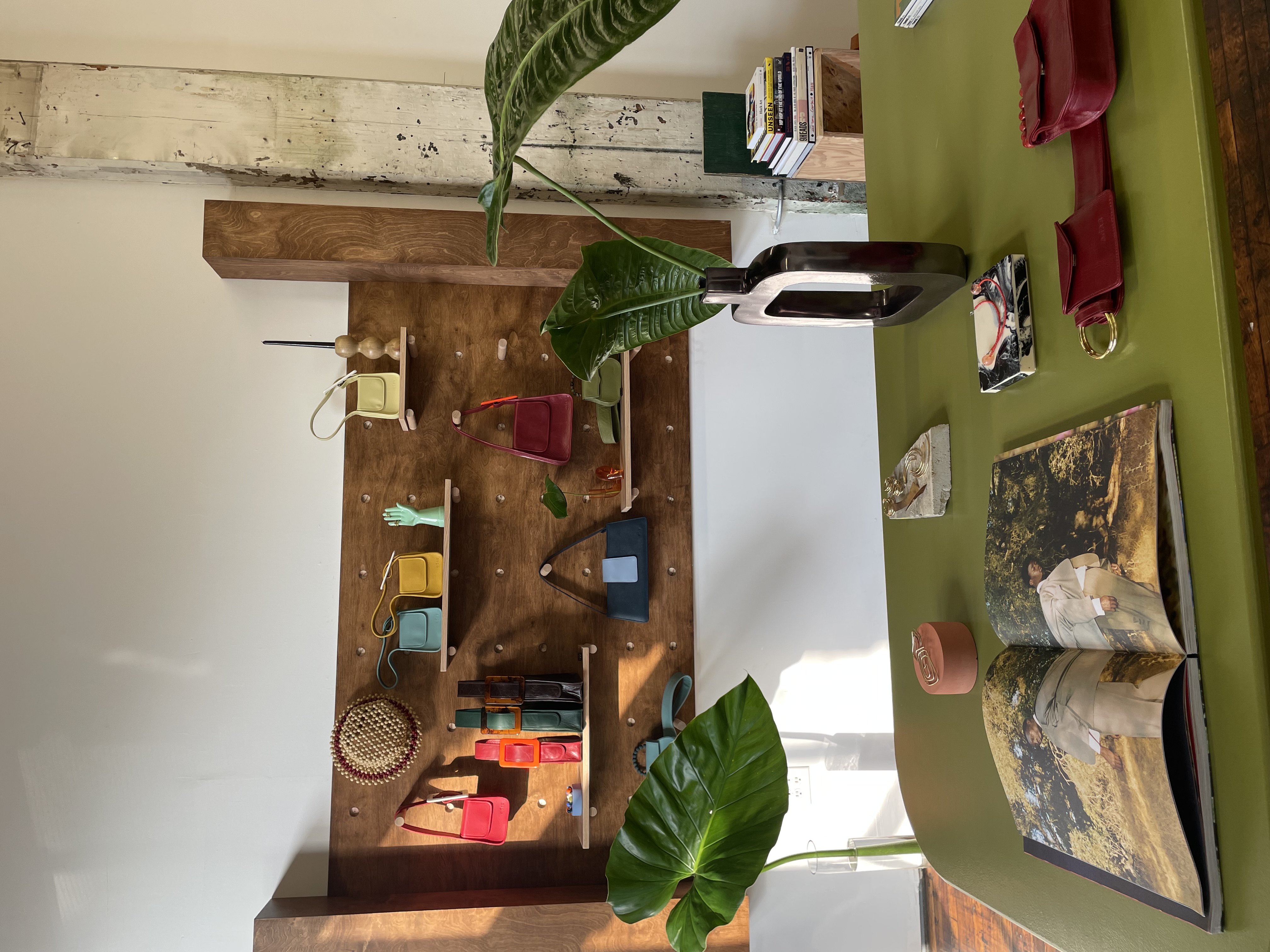
CONVERSATION
January 27th, 2022
By David Eardley
︎On a freezing night two years ago, I met Sade Mims, founder of wunderkind accessories brand EDAS, at a cozy bar in North Brooklyn to interview her about her design process for our old newsletter. We talked sustainability, the body’s relationship to wearables, and interdisciplinary thinking. You can read that interview here :)
Two years later, I called Sade from Mexico City to catch up and discuss her new studio space and showroom, located in Williamsburg, Brooklyn. The space features soaring industrial ceilings, vintage collectibles, and a set of custom furniture Sade commissioned specifically for the space. Throughout it all, you get the sense that Sade has an eye, not just for accessories, but for a very specific aesthetic approach. Her taste blends old and new, earth and sky, hard and soft—in it all, she creates a welcoming environment for her clients and friends to come into her world.
Taking Shapes with Designer Sade Mims
January 27th, 2022
By David Eardley
︎On a freezing night two years ago, I met Sade Mims, founder of wunderkind accessories brand EDAS, at a cozy bar in North Brooklyn to interview her about her design process for our old newsletter. We talked sustainability, the body’s relationship to wearables, and interdisciplinary thinking. You can read that interview here :)
Two years later, I called Sade from Mexico City to catch up and discuss her new studio space and showroom, located in Williamsburg, Brooklyn. The space features soaring industrial ceilings, vintage collectibles, and a set of custom furniture Sade commissioned specifically for the space. Throughout it all, you get the sense that Sade has an eye, not just for accessories, but for a very specific aesthetic approach. Her taste blends old and new, earth and sky, hard and soft—in it all, she creates a welcoming environment for her clients and friends to come into her world.
︎It’s so funny to be sitting here with you now, two years since our last interview. So much has changed.
I think that was our first time sitting down to talk. I met you before, in passing, but that was like our first sit-down—just vibing and talking and stuff. It was nice.
I remember being so nervous because I had been told so many cool things about you. Your brand, the big creative dinners you would throw. And this was before we had a big audience for Pink Essay. We had such a good time though. At the end I was like, “This was really a really great experience.”

EDAS Studio + Showroom
And obviously it worked out because we're friends now. It's funny to be sitting here like two years later and to be doing this again. For you especially, so many things have changed, from your products to the awards you’ve received to the special grants—what has been, like, the biggest thing that has happened to you since our last interview?
I feel like my point of view has become a lot clearer, for myself, but also more importantly to our audience and our community. I always had dreams of merging all these worlds; making a conversation that isn’t just about just wearable accessories, but about accessorizing the home, the body, the mind, the spirit—all these things.
I was toying with those ideas back in 2020, but I think they’re a lot clearer now. I think the studio space is a huge reason for that.
Seeing the physical representation of that in the studio, it's really clear to me like what your vision is, both aesthetically and metaphysically.
I used to feel this pressure from the fashion world: you do fashion and that's what you do. Like you’re somehow not allowed to merge all these things or it won't really be tasteful or successful. And to me I've always thought that was odd. I alway thought that the world can be so many different things, under this one umbrella. Now that I'm able to clearly convey that without shame or guilt, letting go of self-doubt and these feelings—now I've completely released all of those things and leaned in wholeheartedly to my bigger vision.


Do you feel like having a physical space has helped you to anchor your vision in a time and place?
For sure, because I do think it's one thing to read the vision, to see it in images, but if you can have a full-on, in-person connection and hit all the senses at one time—I think that is the most real way that I take in things.
So the space has allowed for our vision to just be more clearly communicative. When you walk in, you see the bags, you see the table, you see the paintings that are works in progress. It’s a showroom, but it also acts as a really deep workspace. I wanted it to still feel like a work environment, which is why I was so conscious about choosing a building filled with craftsmen and and people who work with their hands.
One thing about EDAS that is really interesting to me is the way that it merges aesthetics and wearability. Clearly, they're beautiful pieces, but they're also meant to be used and to last. I think that's reflected also in your studio because you have this combination of very high level aesthetic pieces, like the big table and the pegboard that are also used every day in the space.
I love that you said that—that’s what it is for me. That's what's in my head.
Could you tell me a bit more about these pieces you designed for the space?
Working at Home Union, years ago, was a really big inspiration for me, in terms of my love for furniture and finding what I liked—what eras and designers I was attracted to. I think I've always known that I wanted to design furniture. Ironically enough, I met Noah, the maker of my pieces, at that store.
So when I knew that I was ready to design these pieces, I knew I wanted to work with a Black maker. I reached out to him and the rest went from there. We had lunch around the corner from my apartment and I came with all these sketches—all my ideas, color swatches. I remember him laughing; he was like, “Wow, I love how excited you are.”

Custom Table
We talked through the table concept—it wasn’t difficult, just had some limitations—because I was so specific about wanting it to solely just be three pieces, and one of the legs was a circle. We had to factor in all of these different details to make it work.
It’s cool how you were able to keep him in your mind and collaborate down the road. It’s what the design community needs: building relationships.
Relationships. I truly agree because he and I now are great friends. We hang out all the time. We speak a very similar language. And since then, he's been commissioned so much through that opportunity, which makes me so happy.
The pegboard was a great project too. I had this idea for it, but I’m not a woodworker—Noah elevated it to something fun and interactive. Which is great, because that’s what EDAS is all about. When people visit the showroom, I want them to feel welcome to interact with the pieces without pressure to buy something.

Custom Pegboard
What are dreams for the space beyond what you have now?
I definitely want to incorporate some sort of music element. We have a really cool event happening this year with this archeologist: he collects old periodicals of Vibe Magazine and XXL—all hip hop culture. He has this really great platform he’s created in Atlanta called Rap Style Archeology.
I’d love to collaborate with a bunch of people I’ve dreamed about having in here. And there’s already some stuff in the works. Overall, I want the space to be a hub. It feels really like something that will just evolve as I do.
It feels like it’s definitely on the way to being that. It’s set up to welcome people. Thinking about your process of setting up the space, what advice do you have for young creatives that are working and who want to establish a physical space for themselves like this one?
I talk to my mother a lot about this. The first thing is to take your time. I know that sounds so cliche, but I truly believe that when you take your time to build out the space, you’ll feel confident about and inspired, and it will read through whoever else comes in. As creatives, sometimes we get so excited and rush to do these things. I've been there too, but that is the one thing I made sure of—that with this space I took my time. And if that meant holding on to the space for almost a year before it can open, that's okay for me.
You’ve also got to think about how to make it sustainable, because space is expensive. Think about your programming and how it can bring you income. It’s something that I never had to think about in the past, but I’m really thinking about it now.
I think it’s great advice: thinking both creatively and practically.
In the end, I feel so good about the space. I feel good about the pace that I'm going and about finding my groove. It’s important to find your own personal pace: I think when you really do lean into your own thing, the world will be attracted to it.︎
Explore more of Sade and EDAS at @sademims and @edas.

